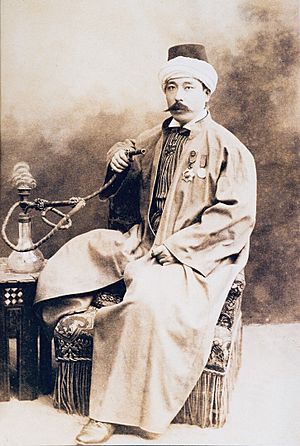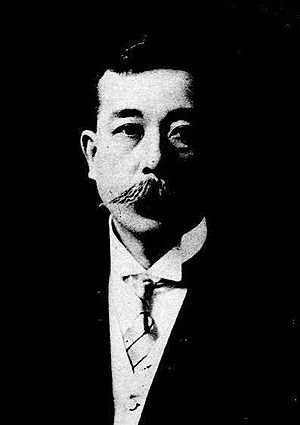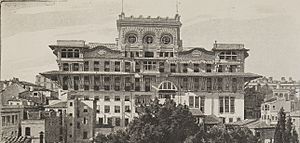Yamada Torajirō facts for kids
Yamada Torajirō (Japanese: 山田寅次郎, born August 23, 1866 – died February 13, 1957) was a Japanese businessman and expert in tea ceremonies. He is known for helping to start friendly relations between Japan and Turkey. He was one of the first Japanese people to become a Muslim and travel to Mecca for the Hajj. He changed his name to Abdülhalil and later to Yamada Sōyū (Japanese: 山田宗有) after 1923.
Yamada arrived in Istanbul, Turkey, in 1892. He brought money to help the families of sailors who died when the Turkish ship Ertuğrul sank. He lived in Istanbul for 13 years, returning to Japan in 1905. Even though he didn't focus on big political or economic deals, his actions helped Japan and Turkey become closer. He acted like an unofficial ambassador, shared Japanese culture with the Turkish people, and wrote many books about Turkey. His efforts are seen as a key reason for the strong friendship between the two countries today.
Contents
Early Life of Yamada Torajirō
Yamada Torajirō was born in 1866 in Edo (which is now Tokyo). His family was a high-ranking samurai family. When Yamada was seven, his family moved to Edo.
At age fifteen, he was adopted by a tea master named Yamada. He then took on the Yamada family name. He studied the Japanese tea ceremony in schools in Edo and Yokohama. He also learned several languages, including Chinese, English, German, and French.
The Ertuğrul Ship Incident
In 1889, the Ottoman Empire sent a ship called the Ertuğrul to Japan. It was a friendly visit. However, the Ertuğrul sank off the coast of Wakayama Prefecture on September 16, 1890. More than 500 sailors died, making it one of the biggest sea accidents of its time.
Yamada Torajirō started a campaign across Japan to collect donations. He worked with major newspapers like Osaka Asahi Shimbun and Tokyo Nichi Nichi Shimbun. Over two years, Yamada collected 5,000 yen. This amount would be worth about 100 million yen today! This donation drive is seen as the first international relief effort by the Japanese Red Cross Society.
To deliver the money, Japan's Foreign Minister, Aoki Shūzō, suggested Yamada go to Turkey himself. So, Yamada left Yokohama on January 30, 1892. He sailed on a British ship called Pasan. On this trip, Yamada met Nakamura Kenjirō, a former naval officer. Both men wanted to start trade and good relations with the Ottoman Empire.
Yamada Arrives in Istanbul
Yamada arrived in Istanbul on April 4, 1892. He met the Ottoman Foreign Minister, Mehmed Said Pasha, and gave him the donated money. He also gave Sultan Abdul Hamid II some special family items. These included samurai armor, a helmet, and a sword.
The Sultan asked Yamada to stay in Turkey for two years. They became good friends. With help from Shōtarō Noda, Yamada began teaching Japanese to army students. It is believed that Mustafa Kemal Atatürk, who later became the first President of Turkey, was one of his students. Yamada briefly returned to Japan in 1893. He gave a speech about the Ottoman Empire and Egypt. This showed Japan's growing interest in trading more in that part of the world.
Starting a Business in Istanbul
In the summer of 1893, Yamada returned to Istanbul. He opened a store called Nakamura Shoten with Nakamura Kenjirō. At that time, they were the only two Japanese people living permanently in Istanbul. Japan and the Ottoman Empire didn't have official diplomatic ties yet. However, the Ottoman government allowed them to run their business.
Yamada built good relationships with the Istanbul Chamber of Commerce. They allowed him to run his shop as a "commercial museum." He also became friends with Spirakis Alexandritis, the Chamber's General Secretary. Yamada rented a shop on Pera Street for Nakamura Shoten.
Over time, the shop became an important stop for Japanese visitors to Istanbul. It first opened at Hazzopulo Pass and later moved to the Beyoğlu District. The Sultan and his family loved Japanese goods. They bought many Japanese household and decorative items from the store. Japanese products became very popular in Istanbul. This was partly because of a growing interest in Japan across Europe. The Turks also admired Japan's rapid modernization. Today, many items sold at Nakamura Shoten can be seen in palaces like Dolmabahçe Palace and Topkapı Palace.
Yamada's Reports to Japan
From 1895 to 1899, Yamada wrote many articles about Turkey for the Japanese magazine Taiyō magazine. He also translated Turkish plays, like Dağlı Kız (The Daughter of the Mountain) and Kıskançlık (Jealousy).
During this time, Yamada wrote articles such as The Real Circumstances of Turkey and Egypt and Women of Turkey. He also reported news from Istanbul, including the Occupation of the Ottoman Bank in 1896.
During the Russo-Japanese War, the Japanese government asked Yamada to secretly watch the Bosporus strait. They wanted to know if Russian warships were moving through it. On July 4, 1904, he reported that three Russian warships had passed through the Dardanelles. At this time, the Turks became very interested in Japan. Japan had quickly modernized and was competing with powerful European countries. Since Russia was a threat to Turkey, the Turks were happy to hear about Russia's defeat.
Returning to Japan
Yamada returned to Japan in 1905. That same year, he started a Turkish-Japanese business for making cigarette paper in Osaka. He made his religious journey to Mecca in 1914 after a trip from Turkey. He became a master of a tea school called Yamada Soyu.
In 1911, he published a picture book called Toruko Gakan (A Pictorial Reflection of Turkey; Japanese: 土耳古畫観). In this book, he tried to explain Istanbul and Islam to people in Japan. In 1931, he visited Turkey again and met with President Mustafa Kemal Atatürk. Yamada Torajirō passed away in 1957. He had published his autobiography, titled Shingetsu. The 16th-century samurai armor he gave to Sultan Abdülhamid II is now on display in Topkapi Palace.




